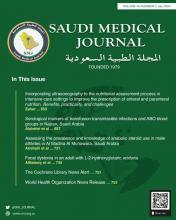Review Article
Incorporating ultrasonography to the nutritional assessment process in intensive care settings to improve the prescription of enteral and parenteral nutrition. Benefits, practicality, and challenges
Zaher discuss the current data regarding the feasibility and practicality of using ultrasound (US) measurements in the intensive care unit (ICU) and we also aim to discuss the potential benefits of incorporating US measurements as part of the nutritional assessment process. Overall, the data suggest that using US as part of the standard anthropometric assessment for critically ill patients is a promising tool to track variations in muscle mass. It is recommended to train dietitians on utilizing US for body composition measurements.
see page 653
Steps of assessing muscle mass by ultrasound.
Original Articles
Serological markers of transfusion transmissible infections and ABO blood groups in Najran, Saudi Arabia
Alshehri et al emphasis on implementing robust screening measures for donated blood is underscored by this study. There is the need for future study to extensively evaluate transfusion transmissible infections (TTI) status to enhance our understanding of the trend in TTI. The AB positive blood group exhibited the most positivity for TTI markers, followed by O positive blood group. Similarly, association was found between ABO group and HBsAg, anti-HBc, and anti-HCV markers positivity. Blood donation data of 4120 donors, spanning from January to December 2020, were retrospectively reviewed.
see page 667
All blood groups versus serological markers of transfusion transmissible infections (TTI) from positive subjects.
Assessing the prevalence and knowledge of anabolic steroid use in male athletes in Al Madina Al Munawara, Saudi Arabia
Alrehaili et al assess the prevalence of anabolic steroid use and the level of knowledge on anabolic steroids among 150 male athletes aged between 18 and 23 years (56.2%) and were single (79.3%) from Al Madina Al Munawara, Saudi Arabia. Thirty-two percent reported using anabolic steroids, mainly to increase muscle mass, following coaches’ advice (46.1%). One-third of the male athletes surveyed used anabolic steroids, influenced by accessibility and social contact, rather than healthcare guidance. This highlights the need for greater awareness of the long-term health risks, ideally through education provided by sports medicine specialists.
see page 731
Case Report
Focal dystonia in an adult with L-2- hydroxyglutaric aciduria
AlBalawy et al presents a 27-year-old female with abnormal right upper limb movement for 4 months. She did not have any complaints of regular or chronic headaches, visual disturbances, episodes of loss of consciousness or convulsions, urination problems, or constipation. She is mobile independently and can even climb the stairs. She can eat, drink, use the bathroom, and wash herself without help. Brain MRI revealed diffuse bilateral symmetrical subcortical white matter hyperintense signals. Two-hydroxyglutaric acid in urine was elevated and the whole genome sequencing revealed a homogeneous pathogenic variant of the L-2-hydroxyglutarate dehydrogenase gene.
see page 745
Magnetic resonance axial fluid attenuated inversion recovery (FLAIR) images showing bilateral symmetrical frontal and parietal cortical, subcortical, basal ganglia (A) and dentate nuclei (B) hyperintense signals.
- Copyright: © Saudi Medical Journal
This is an Open Access journal and articles published are distributed under the terms of the Creative Commons Attribution-NonCommercial License (CC BY-NC). Readers may copy, distribute, and display the work for non-commercial purposes with the proper citation of the original work.









